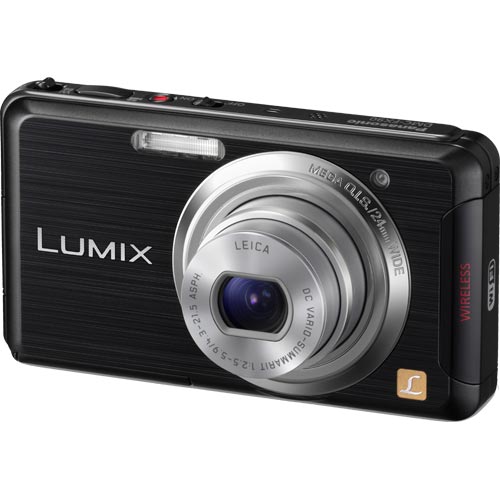
Panasonic has announced new additions to its Lumix camera line, adding a wide range of capabilities and features designed to appeal to both casual and experienced photographers—including powerful zooms, 3D shooting capability, and Wi-Fi.
First up, the Lumix FX90 is a compact point-and-shoot camera with integrated Wi-Fi capability to enable immediate social sharing of images—so long as you’re within range of a Wi-Fi network, anyway. The FX90 sports a 12.1 megapixel sensor, 5× optical zoom, a 30inch LCD display, along wit optical image stabilization, “Sonic Speed” autofocus for fast shooting times, and Intelligent Auto mode that enables features automatically based on the detected shooting environment—and those features include face tracking, face recognition, motion de-blur, scene selection and intelligent exposure. There’s also a dedicated Wi-Fi button that opens up a Wi-Fi connection (where available: WPS supported) enabling immediate sharing via Flickr, Picasa, YouTube, and Facebook. Oh, and it shoots 1080p video. Panasonic hasn’t announced pricing, but expect to see the FX90 in the next few months.

Folks not scared of a little heft in their cameras might look at the Lumix FZ150, which features a 12.1 megapixel resolution and a mammoth 24× optical zoom lens that can be used for both stills and HD (1080p) video. The FZ150 sports a “Light Speed” autofocus that can nab subjects in about a tenth of a second, and the camera’s intelligent audo mode can bring together optical image stabilization, scene selection, Motion Deblur, and exposure control. Panasonic also touts the FZ150’s multi-process noise reduction that applies noise reduction to images based on the brightest portions of an image, helping even low-light photos come out clearly, and there’s a 3D Photo mode: the camera takes 20 panning shots then selects the two that can be melded together for the most effective 3D image that users can view on any Viera 3DTV or any MPO-compatible gear.The FZ150 should be available late next month in black for a suggested price of $499.99.
Panasonic has also announced a new premium Lumix “X” series of lenses for its DMC-GF3X and G-series compact system cameras. The first two offerings are 14–42mm and 45–175mm lenses: the first offers an ƒ3.5-5.6 aperture range while the second goes out to ƒ4-5.6. Panasonic is billing the first as the world’s smallest interchangeable digital power zoom lens: it sports an internal zoom motor activated with a side-mounted rocker switch. The result is a zoom system that is far less bulky than Panasonic’s previous Micro Four-Thirds lens offerings. Panasonic plans to offer the 14–42mm lens on its own for $399.99, or with the Lumix GF3 for $749.99, beginning in October. The 45–175mm lens will be available in September for $449.99.


